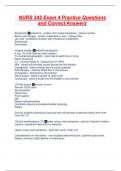NURS 342 Exam 4 Practice Questions
and Correct Answers
Blood tests ✅creatinine - protein and muscle breakdown - kidney function
Blood urea nitrogen - protein metabolism in liver - kidneys filter
Uric acid - breakdown product with nitrogenous metabolism
Bicarbonate
Electrolytes
Imaging studies ✅bedside sonography
X-ray - for HUB (kidney ureter bladder)
IV urography/pyelography - inject dye to watch flow of urine
Renal ultrasound
CT - contrast needs IV, if abdominal CT NPO)
MRI - reveal soft contrast around tissues like the kidneys
Cystograms - inject contrast dye via urinary catheter
Arteriography - vascular blood flow to the kidneys
Venography - blood flow to the kidneys
Renal biopsy - takes a sample to send to lab
Cystoscopy - place a scope into the bladder to look around
UTI risk factors ✅women vs men
Women 18-30 years
Sexual activity
Obstruction
Poor hygeine
DM
Recent catheterizations
Conditions causing incomplete bladder emptying
Elderly
Dont do antibiotic prophylaxis because they will develop a tolerance before then even
have the UTI
Clinical manifestations UTI ✅lower urinary tract symptoms - dysuria, frequent urination,
urgency, suprapubic discomfort or pressure
Upper urinary tract symptoms - flank pain, fever, chills, N/V
Considerations for the elderly - non-localized abdominal pain, cognitive dysfunction,
fatigue, anorexia, slight decline in temperature
,UTI: cystitis, pyelonephritis, dx, tx, nursing goals ✅cystitis: frequency, urgency,
suprapubic pain, dysuria, hematuria, fever, confusion in older adults
Pyelonephritis: flank pain, dysuria, pain at costovertebral angle, same S&S as cystitis
Dx: dipstick for leukocyte esterase and nitrates UA/C&S
Tx: anti-microbial increased fluid intake prevention
Nursing goals: symptomatic relief, teach showers better than baths, perineal cleansing
front to back, voiding after sex, anti-microbial therapy, no scented toilet paper, no
perfumes to perineal area, empty bladder regularly
Medical management UTI ✅diagnosis - amount of bacteria in the urine (UA), urine
culture
Medications - antibiotics
Complications - drug resistance, pyelonephritis
Nursing management UTI ✅assessment - how many times voided, pain when voiding,
do you feel like you emptied your bladder, fever, visualize urine, palpate bladder, vitals
Diagnosis - impaired elimination, acute pain, risk for infection, knowledge deficit, self
care deficit
Intervention - administer antibiotics, teach pt to report flank pain, n/v, fever, increase
their fluids to flush urine
Prevention UTI ✅taking all antibiotics as prescribed
Instruct the client on proper hygiene
Teach the importance of emptying bladder before and after intercourse
Instruct to urinate regularly
Maintain adequate fluid intake
Avoid harsh soaps, bubble baths, powders, sprays in the perineal area
Report S&S of recurrent UTI
Prevention of utis ✅taking all antibiotics as precribed
Instruct the client on proper hygeine
Teach the importance of emptying bladder before and after intercourse
Instruct the client to urinate regularly
Maintain adequate fluid intake
Avoid harsh soaps, bubble baths, powders, sprays in the perineal area
Report S&S of recurrent UTI
Interstitial cystitis (IC) and painful bladder syndrome (PBS) clinical manifestations
✅urgency, frequency
Pelvic pain
Diagnosis of exclusion
Distress, embarrassment, inconvenience, threat to self-esteem, loss of personal control,
desire for normal, sexuality
Looks like utis treated like recurring utis
, Bladder infection
Medical and nursing management IC and PBS ✅identify factors that may exacerbate
or allieviate bladder symptoms
Avoid bladder irritating foods and beverages
Assess the environment and toileting asccessibility
Pelvic cloudy or malodorous urine
Drug therpy
Avoid stress and tight clothing
Pyelonephritis pathophysiology ✅is an inflammation of the renal parenchyma and
collecting system. The most common cause is bacterial infection - backflow of urine
upward
Pyelonephritis clinical manifestations ✅systemic symptoms
Flank pain
Symptoms of a lower UTI
Pyelonephritis diagnosis ✅urinalysis - pyuria, bacteriuria, hematuria, WBC casts
Blood culture - positive if sepsis occurs
Urine culture - positive for infecting organisms
Imaging studies
Pyelonephritis medical management ✅medications - antibiotics (ora; putpatient, IV
inpatient)
Supportive interventions
Complications - renal or perinephric abscess formation, sepsis, renal vein thrombosis,
papillary necrosis, or acute renal failure
Surgery
Nursing management pyelonephritis ✅assessment - look at labs, vitals, blood cultures
Interventions - administer antibiotics, fluids, explain early signs and symptoms of
pyelonephritis, educate prevention
Glomerulonephritis ✅GN is the term for a group of renal disorders characterized by
inflammation of the glomeruli. The part of your kidneys that helps filter waste and fluids
from the blood is damaged.
- acute - result from complication
- chronic - more genetic in nature
Can be caused by various disorders, lupus, vasculitis
Glomerulonephritis clinical manifestations ✅periorbital edema (swelling around the
eyes) or generalized body edema, oliguria (decreased urination)
Hematuria with a smoky or rusty appearance
Proteinuria: usually < 2 grams/day, and or oliguria




